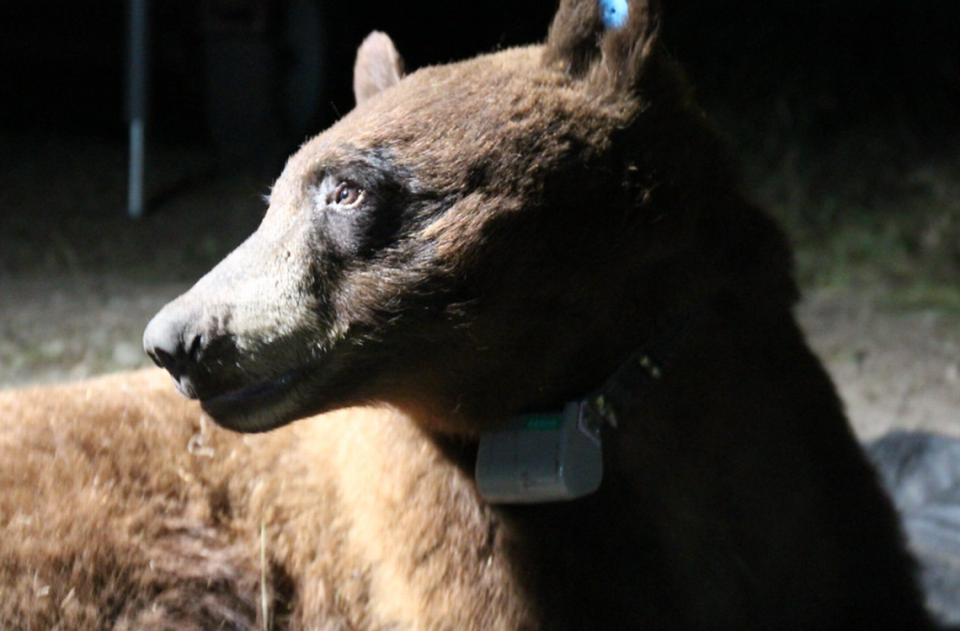This species hadn’t called CA mountains home for 20 years. Now there’s a new resident
Animals living in the Santa Monica Mountains of California have a strange new kind of neighbor, according to wildlife officials.
Biologists with the National Park Service recently captured a 210-pound black bear and outfitted him with a radio collar to track his movements through a western area of the mountain range south of the 101 Freeway, officials said in a news release.
It’s the first time officials have found evidence of a bear living in the area since they started studying mountain lion populations there 20 years ago, officials said.

“He appears to be the only bear here in the Santa Monica Mountains, and he’s likely been here for almost two years based on our remote camera data,” said Jeff Sikich, the lead field biologist on the mountain lion study. “This seems to be our first resident bear in the 20 years we have conducted mountain lion research in the area. It will be interesting to see how he shares the landscape with our other resident large carnivores.”
Biologists named him BB-12. He’s between 3 and 4 years old by their estimate, and though there have been bear sightings before, it’s “the first time biologists have captured and radio-collared a bear in the Santa Monica Mountains,” officials said.
Biologists added BB-12 as a new species to the wildlife study in the Santa Monica Mountains, officials said.
Over the years, bears have been spotted very rarely in the area, officials said.
A young black bear was seen about four miles northwest of the mountains in July 2021, “lumbering” along Reino Road in Newbury Park. And one has been spotted on wildlife trail cameras in one half of the Santa Monica Mountains, from Malibu Creek State Park to the western border of the range in Point Mugu State Park.
Biologists believe this could be the same bear spotted on those trail cameras, officials said.
There was some evidence of bears in the area in the early 2000s, when a bear carcass was found under a landslide in Malibu Creek State Park. Then in 2016, a bear was spotted “three times over three months on wildlife trail cameras in the central portion of the mountains,” but then never seen again, officials said.
There have been rare bear sightings north of the 101 Freeway in the Simi Hills, including one seen near Westlake High School in 2006, and another killed by a car on the highway going north near Lindero Canyon Boulevard, officials said.
But there’s never been evidence of a breeding population in either area, officials said.
The closest black bears live northeast in the Santa Susana Mountains, north of the 118 Freeway, officials said. And grizzly bears used to roam the entire state, but went extinct in the early 1900s.
Black bears are not native to Southern California. About 30 of them were relocated from Yosemite National Park into the San Gabriel and San Bernardino Mountains in the 1930s.
“As this bear gets older and is looking to mate, it might attempt to move back north and cross the freeway again,” Sikich said. “There is no evidence of an existing population here in the Santa Monica Mountains, and therefore likely no females.”
BB–12’s radio–collar will track his movements so officials can figure out where he might attempt to cross the freeway, Sikich said in the release. That will help officials “better understand habitat connectivity for wildlife” in the “urban, fragmented landscape.”
What to do if you see a bear
Bear attacks in the U.S. are rare, according to the National Park Service. In most attacks, bears are trying to defend their food, cubs or space.
There are steps people can take to help prevent a bear encounter from becoming a bear attack.
Identify yourself: Talk calmly and slowly wave your arms. This can help the bear realize you’re a human and nonthreatening.
Stay calm: Bears usually don’t want to attack; they want to be left alone. Talk slowly and with a low voice to the bear.
Don’t scream: Screaming could trigger an attack.
Pick up small children: Don’t let kids run away from the bear. It could think they’re small prey.
Hike in groups: A group is noisier and smellier, the National Park Service said. Bears like to keep their distance from groups of people.
Make yourself look big: Move to higher ground and stand tall. Don’t make any sudden movements.
Don’t drop your bag: A bag on your back can keep a bear from accessing food, and it can provide protection.
Walk away slowly: Move sideways so you appear less threatening to the bear. This also lets you keep an eye out, but don’t make eye contact. Let the bear leave the area on its own.
Again, don’t run: Bears will chase you, just like a dog would.
Don’t climb trees: Grizzlies and black bears can also climb.
If a black bear makes contact and attacks you, fight back. If a grizzly attacks you, it’s better to play dead to show the bear you’re not a threat to it or its cubs.
Watch as an unwelcome guest enjoys relaxing afternoon by pool in California backyard
Bear with 3 ‘yearlings’ bites 74-year-old woman walking dog, Connecticut officials say
Bear carries off hiker’s dog, stashes body, Canadian officials say. ‘Very concerning’

